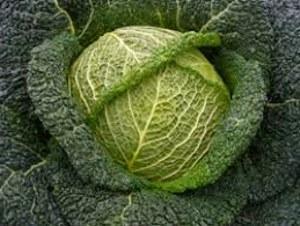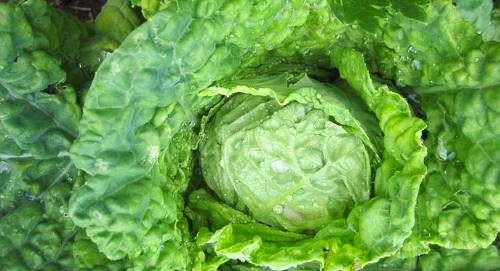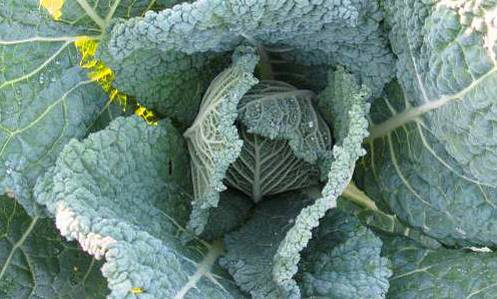Savoy cabbage - growing and care
 Savoy cabbage is a two-year vegetable crop. It is a subspecies of white cabbage. In the first year, it forms a short shoot-stump, on which heads of cabbage are formed. The leaves are large, of different shades of green, inside the head of cabbage is light green. It differs from ordinary white cabbage in that the leaves are not smooth, but bubbly, the head of cabbage has a loose structure. The weight of the heads, depending on the grade, is 0.5 - 3 kg. Savoy cabbage is inferior to white cabbage in terms of yield, but it is distinguished by its taste, high protein and vitamin content. In the second year, the plant throws out a long branched stem, on which inflorescences are formed. Seeds remain viable for up to 5 years. Find out:how much and how to cook cauliflower.
Savoy cabbage is a two-year vegetable crop. It is a subspecies of white cabbage. In the first year, it forms a short shoot-stump, on which heads of cabbage are formed. The leaves are large, of different shades of green, inside the head of cabbage is light green. It differs from ordinary white cabbage in that the leaves are not smooth, but bubbly, the head of cabbage has a loose structure. The weight of the heads, depending on the grade, is 0.5 - 3 kg. Savoy cabbage is inferior to white cabbage in terms of yield, but it is distinguished by its taste, high protein and vitamin content. In the second year, the plant throws out a long branched stem, on which inflorescences are formed. Seeds remain viable for up to 5 years. Find out:how much and how to cook cauliflower.
Requirements for soil, temperature and humidity
Savoy cabbage is a light-loving plant. Long daylight hours favorably affect the formation of heads of cabbage.
Of all types of cabbage, Savoy cabbage has a high frost resistance. Some of its late-ripening varieties are especially resistant to cold weather. Seed germination occurs already at a temperature of + 3 ° C, and intensive growth seedlings occurs at 16-18 ° C. Temporary cold snaps up to 8 ° C slow down the development of plants, but do not stop it. Sprouts of medium and early varieties tolerate short-term frosts up to -1-2 ° С, late ones - up to -5-6 ° С.
Savoy cabbage seedlings tolerate lack of moisture better than other types of cabbage, but adult plants are moisture-loving. The moisture evaporates intensively through the large leaves, and the plants need regular watering.
The culture prefers fertile soils and is responsive to fertilizers... Late varieties are more demanding for feeding than early ones. When growing Savoy cabbage in the Urals and in the Middle Lane, they use mainly mineral fertilizers... The specificity of these regions is such that only early ripening varieties manage to form in a short summer. Plants develop quickly, and organic matter decays slowly, lagging behind this process.
Bad predecessors of Savoy cabbage are: radishes, turnips, radishes, cabbage, tomatoes, good ones are potatoes, carrots, legumes. Change the location of the Savoy cabbage annually. It is recommended to re-plant the vegetable on the beds no earlier than after 4 years (see. photo of Romanesco cabbage).
Popular varieties of savoy cabbage
Depending on the timing of ripening, varieties of savoy cabbage are divided into:
- early maturing - 105-120 days;
- mid-season - 120-135 days;
- late maturing - more than 135 days.
Popular varieties of early ripening savoy cabbage:
- Gold early. Heads weight up to 1 kg. Resistant to cracking.

- Anniversary. Heads weight up to 0.8 kg. Prone to cracking.

- Mila 1. Heads weight up to 3 kg. A productive variety that can be grown in heavy soils.

- Julius F1 Heads weight 1.5-3 kg. Ultra-early hybrid.

Popular mid-season Savoy cabbage varieties:
- Melissa F1 Heads weight up to 3 kg. The hybrid is resistant to cracking.

- Sphere. Heads weight up to 2.5 kg. Cracking resistant grade.

Popular late-ripening varieties of savoy cabbage:
- Ovassa F1 High-yielding hybrid bred in Holland.

- Twirl 1340. Heads weight up to 3 kg. High-yielding variety.

- Verosa F1. Heads weight up to 3 kg. Frost-resistant hybrid. Suitable for long-term storage.

- Morama F1. Heads weight up to 4 kg. The hybrid is the result of crossing Savoy and white cabbage. The leaf surface is smoother.

Growing Savoy cabbage seedlings and planting in the ground
How to grow savoy cabbage properly?
First of all, you need to prepare the ground. Before the autumn digging, they bring organic fertilizers at the rate of 5 kg / 1 m2... In the spring, the soil is harrowed to fill it with moisture. Before planting cabbage, the site is dug to a depth of 15 cm.
Seeds of early ripening varieties for seedlings are planted in mid-March, mid and late-ripening - in mid-April. After the sprouts appear, the temperature is reduced to 8-10 ° C.
Watering begins when embryonic leaves appear. Seedlings are watered in the morning, followed by airing. In bright sun, the seedlings are shaded with a newspaper dipped in water.
Seedlings dive in about 2 weeks. It is recommended to transplant cabbage into nutritious pots. The root of the plant is trimmed one third of its length.
Disembarkation is carried out in 40-45 days. By this time, 4-5 true leaves should be formed. For early varieties in the garden, well-lit areas are chosen, preferably on the southern slope. If the weather is cool, then the plants are covered with film or caps to avoid shooting.
Planting early maturing varieties can be divided into several periods until the end of May. Mid-ripening and late-ripening - planted in June-early July.
Planting schemes for savoy cabbage:
- early maturing - 35x40 cm;
- mid-season - 50x50 cm;
- late ripening - 60x60 cm.
Young plants planted in the ground are recommended to be shaded for 2-3 days.
Care
Savoy cabbage care includes weeding, watering, feeding, pest control.
The first loosening of the soil 5-7 cm deep is carried out after planting the plants in the ground. As it grows, the depth of loosening is increased to 15 cm. The denser the soil, the deeper it needs to be loosened. After 3-4 weeks, the plants are spud.
Watering is carried out once a week, in hot weather the frequency should be increased. Early-ripening varieties are especially demanding on moisture in May, mid-ripening and late-ripening varieties - in July-August.
After the cabbage begins to grow, the first feeding is done. From organic matter, mullein is used (1:10).
Of mineral fertilizers, the following composition is used:
- water - 10 l;
- urea - 15 g;
- superphosphate - 40 g;
- potash fertilizers - 15g.
The next feeding is done in the head curling phase. During this period, the concentration of phosphorus and potash fertilizers is increased by 1.5 times.
Savoy cabbage is less prone to pests than white cabbage. The leaves are periodically examined, the egg clutches are removed. Dusting is also used to control pests. wood ash.
Harvesting and storage
Savoy cabbage is harvested from the end of June. It is important to remove heads of cabbage in a timely manner, which are prone to cracking. There is also a way to prevent cracking. For this, the lower leaves are removed or the root is trimmed with a shovel.
Late varieties tolerate cold weather and light frosts well. Taking advantage of this feature, some gardeners leave cabbage in the beds under a layer of snow in winter and cut it as needed, shoveling the snow.
Savoy cabbage is stored in boxes or on shelves, laid out in one row. The optimum storage temperature is -1-3 ° C.